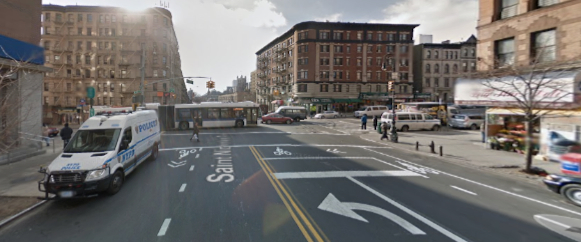
A resident of Upper Manhattan who said she was almost hit, and was then harassed, by NYPD officers as she rode her bike has given up on her complaint to the Civilian Complaint Review Board, which made no progress on the case for close to a year after the incident.
En route to Central Park, Joan (not her real name) was headed south on St. Nicholas Avenue, through the 30th Precinct, at 6:30 a.m. on July 31, 2013. As she crossed 145th Street, she told Streetsblog last year, “a cop car double-parked on the right made a U-turn in front of me — apparently without looking or he would’ve seen my bright orange jersey in his mirror.”
“Thankfully I just barely missed a collision,” Joan said. “After passing I heard the cop yelling so I stopped and turned around. The cop in the passenger seat called me a ‘Jackass’ three times, gave me the finger, and the driver took off.”
She saw the car number — 2516 — but did not see if the marked cruiser was assigned to the 30th Precinct.
Joan filed a complaint with the Civilian Complaint Review Board, an independent agency that, according to its web site, is “empowered to receive, investigate, mediate, hear, make findings, and recommend action on complaints against New York City police officers alleging the use of excessive or unnecessary force, abuse of authority, discourtesy, or the use of offensive language.” She sat for an in-person interview in August, which the CCRB audio taped. When she hadn’t heard anything by early November, she emailed the assigned CCRB investigator.
The investigator responded by email the next day. She told Joan she had some follow-up questions — which according to Joan turned out to be questions she addressed during her interview. Still, she answered them again, this time in writing.
“Why did you believe that both of the officers inside of the police vehicle were uniformed?” the investigator asked. (Joan replied that she saw both of them from the chest up.) “Were there any witnesses that you can identify and/or provide their names and contact information, of this incident?” (There weren’t.)
In addition, emails show the investigator informed Joan that her complaint about almost being hit by the officers’ patrol car was outside the CCRB's jurisdiction, and would be taken up by a different agency, which would be in touch.
Joan says she got several written notices from the CCRB, but none of them indicated that the case was moving closer to mediation with NYPD — the resolution suggested by the CCRB. After five months, she felt like the investigator was waiting her out, or even trying to catch inconsistencies in her story. CCRB investigations, she was told, can take between eight and 12 months.
Then, toward the end of June — 11 months after the incident — the CCRB asked Joan to come in and look at photos of officers. At that point, she’d had enough.
“Seriously, what are the chances I remember what this guy looks like?” she told Streetsblog. “I don't expect any resolution at this point.”
As for the near-collision, the investigator didn’t tell Joan what agency would be handling that part of the complaint, and she never heard anything else about it.
"I'm very disappointed in how this has turned out,” says Joan. “I was assured that the complaint was being taken very seriously, but now, a year later, it just seems like lip service. From where I stand, CCRB is a part of the problem, rather than the solution."
The CCRB has a new chair, civil rights attorney Richard Emery. According to the Daily News, Emery wants to change the way the agency handles citizen complaints, in order to alert NYPD brass to “troubling trends among police officers.” Another Emery initiative, the Daily News reports, is “immediately offering mediation to complainants.”





